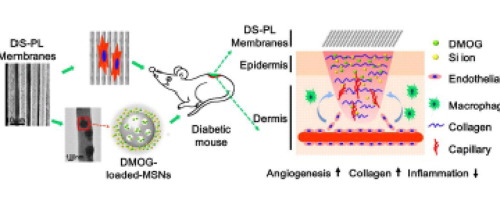Acta Biomaterialia ( IF 9.7 ) Pub Date : 2018-02-15 , DOI: 10.1016/j.actbio.2018.02.010 Xiaozhi Ren , Yiming Han , Jie Wang , Yuqi Jiang , Zhengfang Yi , He Xu , Qinfei Ke

|
A chronic wound in diabetic patients is usually characterized by poor angiogenesis and delayed wound closure. The exploration of efficient strategy to significantly improve angiogenesis in the diabetic wound bed and thereby accelerate wound healing is still a significant challenge. Herein, we reported a kind of aligned porous poly (L-lactic acid) (PLLA) electrospun fibrous membranes containing dimethyloxalylglycine (DMOG)-loaded mesoporous silica nanoparticles (DS) for diabetic wound healing. The PLLA electrospun fibers aligned in a single direction and there were ellipse-shaped nano-pores in situ generated onto the surface of fibers, while the DS were well distributed in the fibers and the DMOG as well as Si ion could be controlled released from the nanopores on the fibers. The in vitro results revealed that the aligned porous composite membranes (DS-PL) could stimulate the proliferation, migration and angiogenesis-related gene expression of human umbilical vein endothelial cells (HUVECs) compared with the pure PLLA membranes. The in vivo study further demonstrated that the prepared DS-PL membranes significantly improved neo-vascularization, re-epithelialization and collagen formation as well as inhibited inflammatory reaction in the diabetic wound bed, which eventually stimulated the healing of the diabetic wound. Collectively, these results suggest that the combination of hierarchical structures (nanopores on the aligned fibers) with the controllable released DMOG drugs as well as Si ions from the membranes, which could create a synergetic effect on the rapid stimulation of angiogenesis in the diabetic wound bed, is a potential novel therapeutic strategy for highly efficient diabetic wound healing.
中文翻译:

排列有序的多孔电纺纤维膜,具有受控的药物输送-一种有效的策略,可通过改善血管生成来加速糖尿病伤口愈合
糖尿病患者的慢性伤口通常以血管生成不良和伤口闭合延迟为特征。探索有效改善糖尿病伤口床中血管生成从而加速伤口愈合的有效策略仍然是一项重大挑战。在这里,我们报告了一种对齐的多孔聚(L-乳酸)(PLLA)电纺纤维膜,其中含有二甲基草酰甘氨酸(DMOG)负载的中孔二氧化硅纳米粒子(DS)用于糖尿病伤口愈合。PLLA电纺纤维沿单一方向排列,在纤维表面原位产生椭圆形的纳米孔,而DS很好地分布在纤维中,可以控制DMOG和Si离子从纤维中释放出来。纤维上的纳米孔。在体外结果表明,与纯PLLA膜相比,对齐的多孔复合膜(DS-PL)可刺激人脐静脉内皮细胞(HUVEC)的增殖,迁移和与血管生成相关的基因表达。在体内进一步的研究表明,制备的DS-PL膜可显着改善新血管形成,再上皮形成和胶原蛋白的形成,并抑制糖尿病创面的炎症反应,从而最终刺激了糖尿病创面的愈合。总体而言,这些结果表明,分层结构(排列的纤维上的纳米孔)与可控释放的DMOG药物以及来自膜的Si离子的组合,可能对快速刺激糖尿病创面中的血管新生产生协同作用。 ,是高效糖尿病伤口愈合的潜在新型治疗策略。


























 京公网安备 11010802027423号
京公网安备 11010802027423号